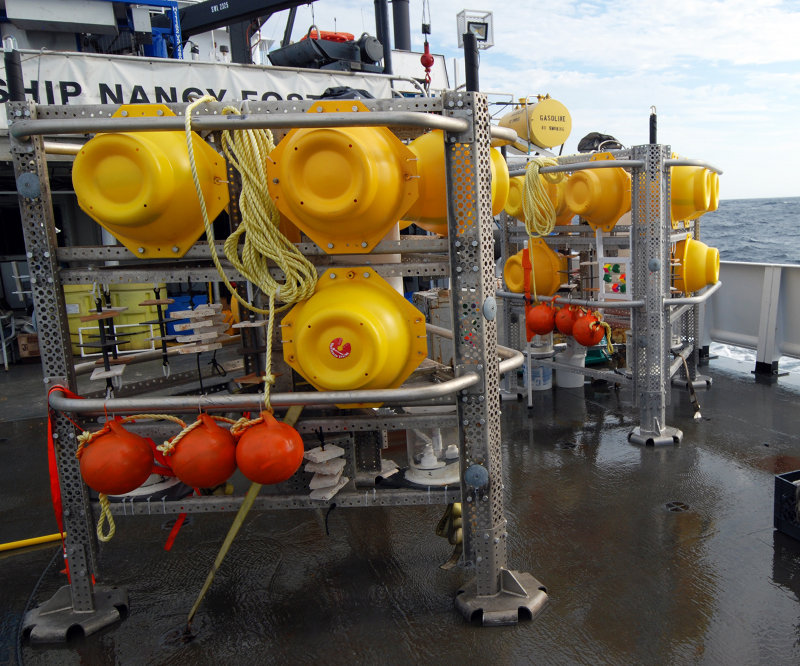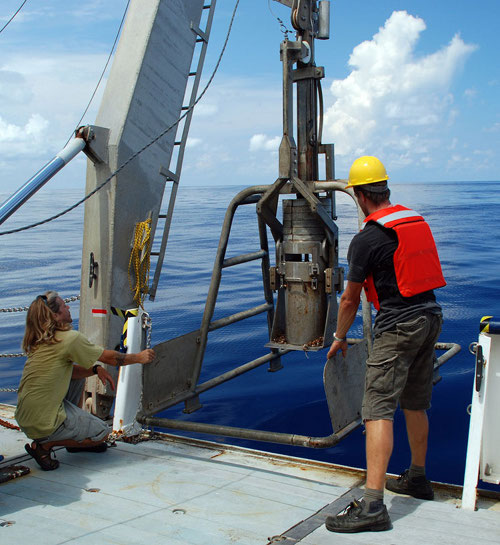
By Steve Ross, Research Professor - University of North Carolina-Wilmington, Center for Marine Science
Sandra Brooke, Associate Research Scholar - Florida State University Coastal and Marine Laboratory
April 30 - May 27, 2013

Two University of North Carolina-Wilmington Benthic Landers that were deployed in 2012. These platforms are deployed from the ship and recovered by remotely releasing the weight that secures them to the seafloor. The four Landers and two moorings were equipped with instruments to measure environmental variables and rate of sediment deposition as well as containing several types of experiments. Image courtesy of Steve W. Ross (UNCW). Download larger version (jpg, 3.2 MB).
This four-year project has a wide variety of scientific objectives to investigate the biology, ecology, geology, and oceanography of two mid-Atlantic canyons off Virginia and Maryland. In addition, archeological sites within and adjacent to Norfolk Canyon will be explored and described.
The 2013 research cruise (30 April-27 May) will be divided into two separate legs; the first leg will explore natural ecosystems and habitats found within the canyons, and the second leg will examine historical shipwrecks and their biological communities. This is the third cruise of the project, and it will benefit greatly from the knowledge gained on the past two cruises (2011 and 2012), facilitating our explorations and collections.

This image shows the NIOZ boxcore being recovered off the starboard side of the ship to collect deep-sea sediment. This equipment grabs a column of sediment and the overlying water and brings it intact to the surface. Image courtesy of Steve W. Ross (UNCW). Download larger version (jpg, 2.2 MB).
In order to maximize valuable ship time, we will conduct 24-hour operations. During the daytime we will use the remotely operated vehicle (ROV) Jason II for 12-16 hour dives to survey biological communities associated with different canyon habitats. We will focus on hard-bottom habitats in search of deep-sea corals but will also explore soft sediments in the canyon axis, methane seep habitats, and consolidated clay outcroppings on the canyon walls.
The video and digital images collected by the Jason II will be used to characterize the different habitats and document the distribution, ecology, and biodiversity of canyon communities. In addition to video surveys, the ROV will be used to collect samples of deep-water corals, other canyon fauna, water samples, and sediment cores.
During the night, we will supplement the ROV samples by using a small trawl and a boxcore and to collect additional fauna and sediments. The ship’s CTD (an instrument that collects conductivity, temperature, depth and other data) will also be used at night to collect environmental profiles of the water column. Water samples will also be collected and analyzed for nutrient level, organic content, heavy metals, and other ocean chemistry.
All of the various data and samples will be used to address multiple objectives including understanding the community structure, taxonomy, age, growth, reproductive biology, and genetic connectivity of deep-sea canyon organisms; their associated microbiology and food webs; and the physical, chemical, and geological conditions associated with each canyon ecosystem.
Deep-sea studies are limited by the short duration of their field work; research cruises are expensive and are usually only two to four weeks long. This provides scientists with just a ‘snapshot’ of information, but in order to understand how biological communities function, we need to know more about the short-term variability of the environment they live in. These data are generally not available for deep-sea habitats.
One of the most exciting objectives of this project is the application of sophisticated technology, deployed on platforms called Benthic Landers and moorings to provide long-term data and monitoring of these environments. The Landers and moorings were placed last year at the head, middle, and the bases of Norfolk and Baltimore canyons, where they will remain for a year, collecting data on temperature, salinity, oxygen, chlorophyll, currents, and monthly sediment deposition. The Landers are also equipped with a series of settlement plates to assess recruitment and colonization rates of benthic fauna and experiments to measure growth and survival of deep-water corals.
Data collected by these instruments and experiments will advance our understanding of the biology, ecology, and oceanography of canyons by bridging the data gap between research cruises. Two landers will be brought up during this May cruise, serviced, and redeployed. All landers and moorings are scheduled for final recovery during September 2013.
The second cruise leg will focus on the historical shipwrecks discovered in 2011 and 2012. High-definition video and digital images collected by the ROV will be used to identify the vessel type, mission, ownership, construction period, and cargo of the ships, and, if possible, to determine how each ship sank.
Images of the shipwrecks will be stitched together to construct a digital photo archive of these historic structures. If eligible, the shipwrecks will be proposed for nomination to the National Register of Historic Places.
The shipwrecks will also be assessed for their value as artificial habitat for canyon fauna by comparing the fishes and invertebrates associated with the wrecks to those found in natural habitats. Damage to the wrecks from fishing or other human activities will be accessed.
This leg will also search for other wrecks that have not yet been located. In addition to the shipwrecks, the marine archaeologists on board will be searching for evidence and possibly artifacts of pre-historic habitation sites.